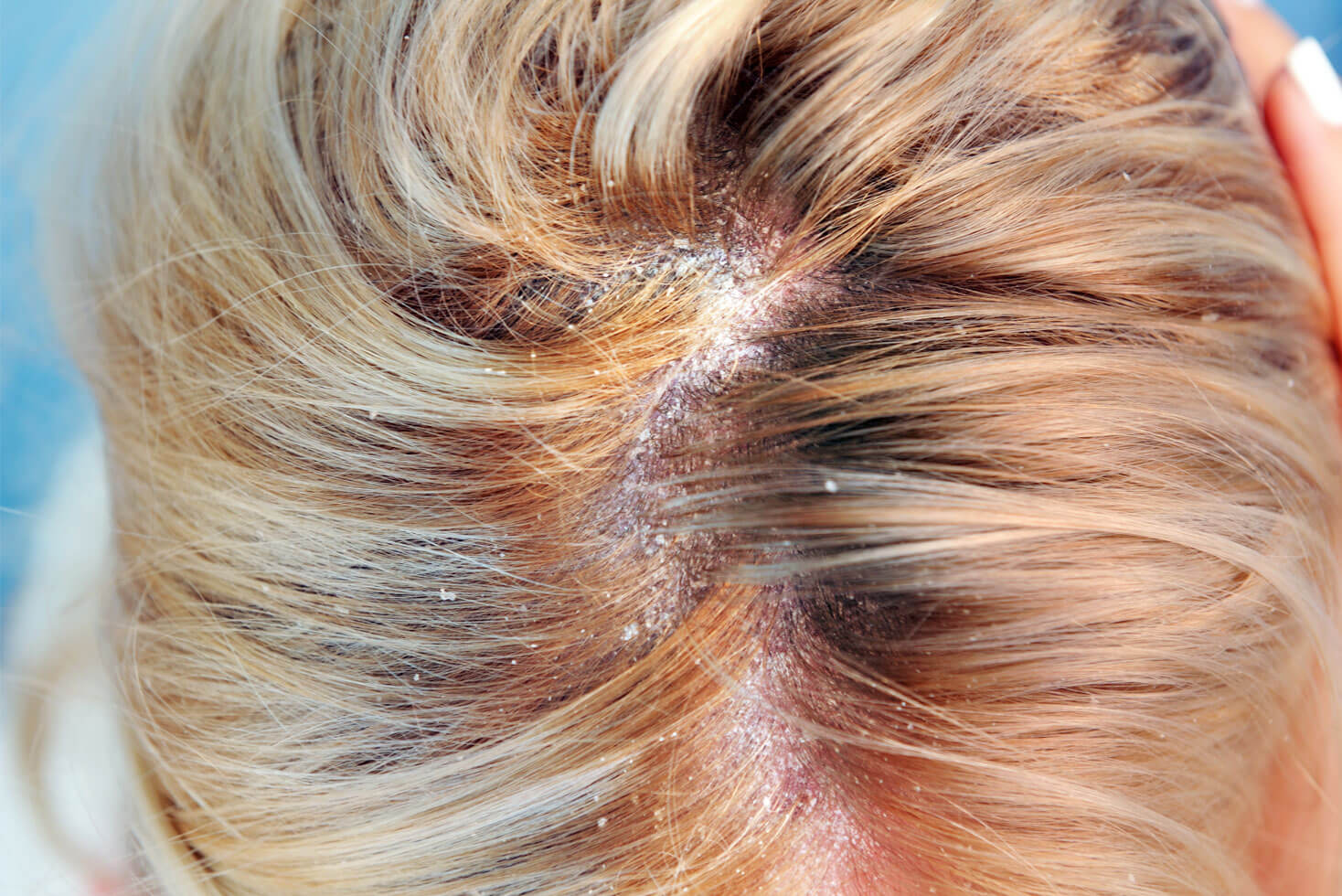What Causes Scalp Fungus and The Best Treatment That Works Instantly!
Updated on
This post may contain affiliate links. As an Amazon Associate, we may earn from qualifying purchases.

Scalp fungus is, unfortunately, a very common issue for people across the world.
It causes itchiness, it’s uncomfortable, and it can even lead to hair loss if you’re not careful. So in this article, we’re going to discuss what scalp fungus is, what causes scalp fungus, and how you can remedy it.
Thankfully, scalp fungus is one of the most common forms of scalp infection and is well-documented. This means that there’s plenty of information about it, and many effective treatments to deal with it.
What is Scalp Fungus?
Scalp fungus is often known as: Ringworm of the scalp or Tinea Capitis.
It’s a fungal infection that affects your scalp and hair follicles.
Some of the most common signs of scalp fungus include:
- Itchiness
- Inflammation
- Bald patches
- Or scaly patches on the head
It’s a highly contagious infection that is common in toddlers and school children. This is due to outbreaks that are easily spread through physical contact.
What Causes Scalp Fungus?
Scalp fungus is caused by fungi known as Dermatophytes. They feed on dead tissues on your hair and outer layers of your skin. They thrive in moist and warm environments such as sweaty skin, which is common on your scalp. Poor hygiene will often cause your scalp fungus to spread more quickly.
Scalp fungus is most commonly caused by transmission from the infected carrier. This can be children, pets, or other adults. It happens from sharing combs, bedding, or other objects like towels. If they have been used by an infected person, then you also risk being infected by scalp fungus.
What Are the Symptoms of Scalp Fungus?
There are many common symptoms of scalp fungus to look for:
- Round patches of skin where the hair has broken off at or above the scalp. These patches will be scaly and dry-looking.
- Patches of scaly skin that seem to be expanding
- Scalp patches that are scaly, red or gray
- Patches of skin that have small black dots where the hair has broken from the scalp
- Red, tender and painful areas on the scalp
- Fragile hair that seems to break off easily
If you notice any of these symptoms, then there’s a likely chance that you may be experiencing scalp fungus.
Luckily, treatment options are available.
How Is Scalp Fungus Transmitted?
One of the most important things to note is that scalp fungus is contagious. This means that it can be passed from one person to another. This makes it vital that you identify if you have scalp fungus so that you can take safety precaution methods. This may involve keeping your towels separate from other household members or limiting skin-to-skin contact.
- Human to Human
- The most common method of transmission is from human to human. This typically involves skin-to-skin contact with an infected person. Children are often carriers of scalp fungus due to the likelihood of transmission at school.
- Animal to Human
- If you have dogs or cats, then they could become carriers of scalp fungus and infect you with scalp fungus. Other animals, such as pigs, horses and goats, can also be carriers.
- Object to Human
- Lastly, scalp fungus can also spread through contact with objects and surfaces that someone with the infection has touched. For instance, if you share a towel or bed linen with someone infected with scalp fungus, you could also be infected.
By understanding these scalp fungus transmission methods, you can limit the possibility of spreading scalp fungus to other family members. Since it’s highly contagious, it’s a good idea to educate everyone in your household with the symptoms and transmission methods to prevent the infection from spreading.
Can Scalp Fungus Affect Other Areas of the Body?
Yes. The fungi that cause scalp fungus can also affect other areas of the body. While still known as a fungal infection, they have different names depending on what part of the body it has infected. If someone in your home has scalp fungus, then it’s likely that these areas of your body can also become infected through human to human or object to human transmission.
- Athlete’s Foot (Tinea Pedis)
- This common fungal infection affects areas between your toes and often the foot as well.
- Jock Itch (Tinea Cruris)
- This affects your genitals, buttocks and inner upper thighs, causing severe itchiness and sometimes pain.
- Body Ringworm (Tinea Corporis)
- Characterized by scaly red rings or rashes that appear on your skin.
If you notice symptom similarities between your scalp fungus and areas of your body, you should seek assistance from your physician. These types of fungus can easily spread from person to person, making it a top priority to deal with the infection as soon as possible.
Treating Scalp Fungus
Now that you understand what causes scalp fungus, it’s important to understand how to deal with it in the most efficient way possible. Since scalp fungus is highly contagious, it’s in your best interest to deal with it as soon as possible.
How is Scalp Fungus Diagnosed?
The most common way to diagnose scalp fungus is to inspect it visually. Your physician may use a Wood’s lamp to light up your scalp and look for signs of scalp fungus. If your physician is unsure, they may take a hair or skin sample from the scalp to confirm their diagnosis. This may take a few weeks because it must be examined in a lab.
Scalp Fungus Treatment
The most common form of treatment is to use antifungal medication or shampoo. This includes Grifulvin V Suspension, an oral medication that is often prescribed by a physician to clear up your scalp fungus. Another possibility is terbinafine hydrochloride, such as Lamisil. In terms of shampoo, there are options such as prescription ketoconazole or selenium sulfide.
Nizoral A-D Antifungal Shampoo
It’s important to note that medicated shampoo cannot stop scalp fungus on its own. Instead, it stops it from spreading and must be combined with other types of medication in order to treat it fully.
The best combination of scalp fungus treatment will be determined by your physician. While there are many over-the-counter medicines to try, we suggest visiting your physician first to determine that it is scalp fungus.
Recovering From Scalp Fungus
Recovering from scalp fungus takes a long time, and you may be required to take medication for a while before you see any noticeable changes. It’s important to check with your physician every few weeks after your treatment is prescribed to keep track of any improvements and changes.
If the cause of transmission was from a pet, then it’s also important to take your pet to a veterinarian to have them examined. This will help prevent reinfection in the future. You’ll also want to focus on prevention methods in the future.
Preventing Scalp Fungus
Scalp fungus is most commonly transmitted from an object or person. As such, it’s important to focus on ways to prevent scalp fungus from happening in the first place. Due to its highly contagious nature, you can help reduce the risk by following these simple steps.
Stay hygienic
Make sure you and your family members stay hygienic by washing every day and shampooing your hair thoroughly. Make sure you also wash your hands at regular intervals to prevent the spread of the infection. You’ll also want to keep your home clean and wash towels often to prevent the fungi from spreading.
Keep animals clean
Inspect and clean your pets on a regular basis to ensure that they aren’t carrying ringworm, which could trigger scalp fungus in humans.
Don’t share personal items
Whether it’s combs, towels, or hairbrushes, don’t share personal items and give everyone in the household their own set. This will drastically lower the chances of an object to human transmission.
Use a clarifying shampoo
A clarifying shampoo as part of your daily routine will help keep your hair clean while providing anti-fungal properties that can protect it against scalp fungus.
Educate yourself on scalp fungus
Scalp fungus isn’t a difficult problem to overcome or prevent, but it does require knowledge of it. Make sure you understand what causes scalp fungus, how to diagnose it, how to treat it, and how to prevent it.
By following these tips, you’ll drastically lower the chances of reinfection or contracting scalp fungus in the first place. At times, being infected by scalp fungus may be unavoidable due to how easy it can be transmitted from person to person. As such, staying hygienic and shampooing your hair with a clarifying shampoo can help protect your scalp.
Summary
Scalp fungus is a common problem due to its highly contagious nature. By focusing on prevention methods such as keeping your scalp clean and using a clarifying shampoo, you can reduce the chances of experiencing scalp fungus yourself.
We also suggest looking into shampoos such as Nizoral A-D shampoo, one of the most common non-prescription over-the-counter ketoconazole shampoos. While it’s not as strong as prescription ketoconazole, it can be an effective way to protect your hair by preventing the scalp fungus from spreading. It’s mainly used to control dandruff, but its antifungal properties can also be used for scalp fungus.
Nizoral A-D Ketoconazole Shampoo
About the Author
 Tina Moretti
Tina MorettiTina Moretti, a passionate hair care enthusiast with over a decade of expertise, dedicates herself to empowering women with proven hair care advice. Recognized for her hands-on experience and trusted guidance, Tina turns every strand into a statement of beauty and confidence.
